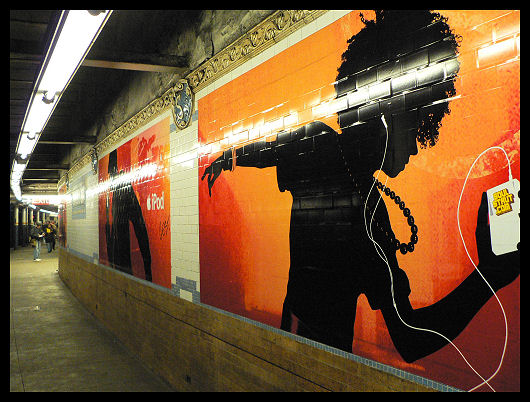In 2005, iPod ads were everyone in the subway. Today, bleeding headphones have become ubiquitous. (Photo by flickr user t_a_i_s)
I found myself on Monday evening awaiting a downtown 4 train on the IRT platform at Union Square. As the downtown 6 pulled out and an express idled on the uptown tracks, it was loud. The automated PA voice kept warning me to stand back from the moving platform; the downtown trains screeched around the sharp curve into the station; and the heated system on the idling uptown express hummed.
It is little wonder then that the noisiest spot in New York City is at a subway station. According to a recent study by Hear the World, the noisiest spot in the city with trains roaring by is the B/D/F/V stop at 42nd St./Bryant Park. The noise levels reach 93 decibels at the subway system’s 18th busiest stop.
According to hearing experts, that level of screech is enough to cause permanent hearing damage, and Craig Kasper, a Columbia doctor who works with Hear the World, urged people to be mindful of the noise. “Once you reach anything over 85 decibels, you are really at risk,” he said. “If you hear a loud noise, just put fingers in your ears.”
Outside of Bryant Park, subways in general were the fourth most noisiest part of New York City, behind the West Side Highway and the bus lanes on 42nd St. east of Fifth Ave. A typical subway ride exposes a straphanger to 80 decibels of sound. Although the new R160s are designed to reduce noise levels both as trains ride the rails and as they brake, there’s only so much engineering can accomplish, and sounds are aplenty underground.
Interestingly, this survey seems to reduce the noise levels found this summer when one group warned of 100+ decibel exposure at some subway stations. Those built around curves are the loudest as trains make more noises braking through twisted sections of track. If only we could go back in time to fix those errors of original engineering over 100 years ago.
Noise on the subways, meanwhile, is not a new phenomenon. As Bill Bahng Boyer, one of my guest columnists over the summer, explained in August, New Yorkers have been complaining about the noise since October 29, 1904, one day after the IRT opened for business. What is a new problem however is headphone bleed. Have you tried to take a relatively silent ride lately? It’s impossible.
Once upon a time, boom boxes were the scourge of New York City subway riders. Those with their noises in magazines would dread the arrival of a gang of youths with a loud radio on for all to hear. It was the ultimate in obtrusive noise pollution, and eventually the combination of a crackdown and the onset of personal audio devices saw boom boxes become a relic of another era.
Today, though, we are subjected to subpar headphone earbuds. Brought about by the iPod revolution, nearly everyone is now satisfied with tinny headphones that leak sound all over the place. Some riders listen at volumes that are death to the ears, and nothing is worse than hearing the strains of something from 15 away in a a half-empty subway cars. Others simply don’t know how bad their headphones are. One day, I imagine, New York City may see an increase in the number of people suffering hearing damage, and the iPod earbuds will be to blame.
For now, we should be mindful of the noise. Obviously, the subways are noisy, and those sounds can impact our life. We tend to tune out the sounds of metal-on-metal, the sounds of air conditioner drones, the screech of brakes. But it’s there, hurting our ears decibel after decibel.






 Over the next few hours, hundreds of thousands of people will flock to airports around the country. Some will take buses and taxis while others take subways and commuter rails. Many will rely on monorails to navigate through terminals, and others will have a short walk to the gate all in a mad dash to get somewhere before Thanksgiving.
Over the next few hours, hundreds of thousands of people will flock to airports around the country. Some will take buses and taxis while others take subways and commuter rails. Many will rely on monorails to navigate through terminals, and others will have a short walk to the gate all in a mad dash to get somewhere before Thanksgiving. On early Saturday morning, for just the second reported time this year, a man
On early Saturday morning, for just the second reported time this year, a man